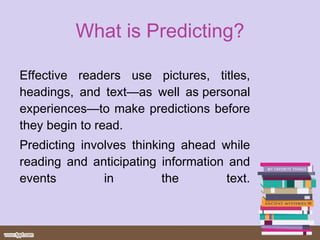Reading Predicitng
- 1. Reading and Prediction By V. Bola?os M. Israelsky
- 2. What is Predicting? Effective readers use pictures, titles, headings, and textĄŠas well as?personal experiencesĄŠto make predictions before they begin to read. Predicting involves thinking ahead while reading and anticipating information and events in the text.
- 3. How is Predicting done? As we read, our eyes do not sweep in a steady movement across the print. Rather, we move our eyes in jumps called eye fixation movements. We scan a line, fixate a point to permit eye focus.
- 4. ?
- 5. Second language learners are not able to predict at all in the beginning stage of reading with much accuracy since their sintax and semantics is limited. This is particularly true for children who not only are learning a second language but also are learning to read at the same time.
- 6. Why is Predicting important? Making predictions activates students' prior knowledge about the text and helps them make connections between new information and what they already know. By making predictions about the text before, during, and after reading, students use what they already knowĄŠas well as what they suppose might happenĄŠto make connections to the text. For doing so, researchers have found that teaching reading should include explicit instruction on strategies used to comprehend text. These strategies include summarizing the main idea, predicting events or information to which the text is leading, drawing inferences, and monitoring for misunderstandings.
- 8. As students move toward independent integration of the strategy, teachers should provide opportunities for them to make, revise, and verify their own predictions before, during, and after reading.
- 9. Lesson Plan
- 10. ?
- 11. THANK YOU!!!










